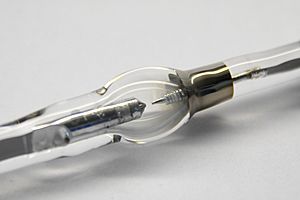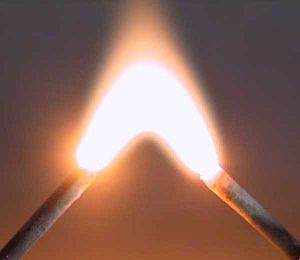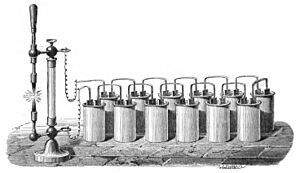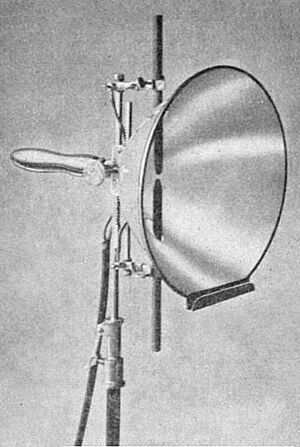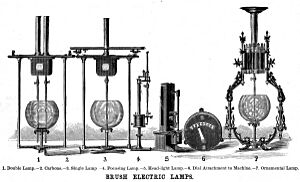Arc lamp facts for kids
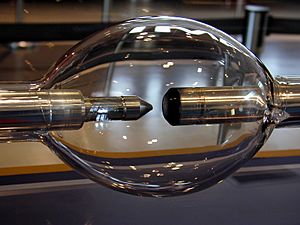
An arc lamp or arc light is a special kind of lamp that makes light using an electric arc. An electric arc is like a continuous spark of electricity that jumps between two points. It's also called a voltaic arc.
The first useful electric light was the carbon arc lamp. It was invented by Humphry Davy in the early 1800s. This lamp used an electric arc between two carbon rods in the air. Starting in the 1870s, carbon arc lamps were widely used to light up streets and large buildings. Later, in the early 1900s, regular light bulbs (incandescent lights) became more popular. However, carbon arc lamps were still used for things that needed a very bright, focused light, like searchlights and movie projectors, even after World War II. Today, carbon arc lamps are mostly replaced by newer lights, but they are still used to create strong ultraviolet light for special purposes.
Now, the term "arc lamp" usually refers to gas discharge lamps. These lamps make light by creating an arc between metal parts (electrodes) inside a glass bulb filled with a special gas. A common example is the fluorescent lamp, which is a low-pressure mercury arc lamp. The xenon arc lamp produces a very bright white light and is now used for many things that carbon arc lamps used to do, like movie projectors and searchlights.
Contents
How Arc Lamps Work
An arc happens when a gas becomes ionized. This means the gas atoms lose or gain electrons, allowing electricity to flow through them. To start an arc lamp, a high voltage is sent through it. This "ignites" or "strikes" the arc. Once the arc starts, it can be kept going with a lower voltage.
To make an arc lamp work, you need two main parts: an igniter and a ballast. The ballast is connected in a series with the lamp and does two important jobs:
- Starting the Arc: When you turn the lamp on, the igniter sends a small current through the ballast. This creates a magnetic field. Then, the igniter quickly stops the current. Because the ballast resists changes in current, this sudden stop creates a very high voltage. This high voltage then "strikes" the arc inside the lamp. This process repeats until the gas inside the lamp is ionized enough to keep the arc going.
- Controlling the Current: Once the arc is stable, the ballast's second job is to limit the amount of electricity flowing through the lamp. This makes sure the lamp gets just the right amount of power to work correctly. If any part of the lamp system breaks, it needs to be replaced with parts that have the same power rating, or the lamp won't work.
The color of the light from an arc lamp can change a bit as it heats up and gets older. Lightning is a natural example of an arc. It happens when the air between the ground and storm clouds becomes ionized by a huge voltage difference.
The electric arc inside an arc lamp can get incredibly hot, reaching thousands of degrees Celsius. The outer glass part of the lamp can also get very hot, up to 500 degrees Celsius! So, you must let the bulb cool down completely before touching it. Often, if these lamps are turned off or lose power, you can't turn them back on right away. You have to wait several minutes for them to cool down (these are called "cold restrike lamps"). However, some lamps, like fluorescent tubes, can be turned back on immediately (these are "hot restrike lamps").
In 1975, David Camm and Roy Nodwell at the University of British Columbia invented the Vortek water-wall plasma arc lamp. This lamp was so powerful that it made the Guinness Book of World Records in 1986 and 1993. It was the brightest continuously burning light source, shining with over 300 kilowatts of power!
Carbon Arc Lamps

In a carbon arc lamp, the electrodes (the parts that carry electricity) are carbon rods in the open air. To start the lamp, the rods are touched together. This allows a low voltage to create the arc. Then, the rods are slowly pulled apart. The electric current heats the carbon tips, making them glow brightly and turn into vapor. As the lamp burns, the carbon rods slowly get shorter. Because of this, the distance between them needs to be adjusted regularly to keep the arc going.
Many clever devices were invented to adjust the rods automatically. One simple type used a solenoid (an electromagnet) connected to the top rod. If the rods touched, the current would increase, and the solenoid would pull them apart. If the arc started to fade, the current would drop, and the rods would move closer together again.
The Yablochkov candle was a simpler arc lamp that didn't need a regulator. However, it could only be used once and lasted only a few hours.
Light from Carbon Arc Lamps
The light from a carbon arc lamp is very similar to natural sunlight. Because they were so bright and harsh, they were mostly used for lighting large areas. Early on, people didn't know about invisible light rays. But they soon found that these lamps produced a lot of infrared and harmful ultraviolet light, which isn't found in sunlight. If the arc was put inside a glass globe, many of these invisible rays could be blocked.
Carbon arc lamps were eventually replaced by safer, more efficient, and easier-to-maintain incandescent and gas-discharge lamps. However, carbon arc lamps are still used today when a light very similar to sunlight is needed. For example, they are used to test how materials, paints, and coatings will wear out or fade when exposed to sunlight. They are also used to test materials for spacecraft that will be exposed to strong sunlight in space.
Most of the visible light and infrared radiation from a carbon arc lamp comes from the positive carbon rod, called the anode. Unlike the metal anodes in other arc lamps, which stay relatively cool, the carbon anode gets extremely hot. This is because the electricity flows into the anode at its hottest point, creating a pit on its surface. This pit glows incredibly brightly, reaching temperatures of 3300 to 3600 degrees Celsius (about 6000 to 6500 degrees Fahrenheit). Because carbon has the highest melting point of any element, it's the only lamp material that can produce light almost as hot as the Sun's surface (around 5500 degrees Celsius or 10,000 degrees Fahrenheit).
History of Arc Lamps
The idea of carbon arc lighting was first shown by Humphry Davy in the early 1800s. Sources disagree on the exact year, but it was around 1802 to 1809. Davy used charcoal sticks and a large battery to create an arc across a 4-inch (100 mm) gap. He noticed that the arc formed a curved shape because of the air currents, and he called it an "arch lamp." This name was later shortened to "arc lamp."
In the late 1800s, electric arc lighting became very popular for public lighting. However, a big problem was that the electric arcs would often flicker and make a hissing sound. In 1895, Hertha Ayrton, a brilliant scientist, wrote articles explaining that this flickering and hissing happened when oxygen touched the carbon rods. In 1899, she became the first woman to present her own paper to the Institution of Electrical Engineers (IEE), titled "The Hissing of the Electric Arc."
Arc lamps were one of the first ways electricity was used commercially. Before this, electricity was mostly for experiments, the telegraph, and entertainment.
Carbon Arc Lighting in the U.S.
In the United States, people tried to sell arc lamps after 1850, but they struggled because there wasn't a steady supply of electricity. So, engineers focused on making Faraday's dynamo (a type of electric generator) better. Many people, including Charles F. Brush, improved the idea. It wasn't until the 1870s that lamps like the Yablochkov candle became more common.
In 1877, the Franklin Institute tested different dynamo systems. The one made by Charles F. Brush worked the best. Brush quickly used his improved dynamo for arc lighting. One of the first places it was used was Public Square in Cleveland, Ohio, on April 29, 1879. However, Wabash, Indiana, claims to be the first city fully lit by "Brush Lights." Four of these lights were turned on there on March 31, 1880. Wabash was small enough to be lit entirely by just four lights, while the Cleveland installation only lit a part of that bigger city. In 1880, Brush started the Brush Electric Company.
The bright and strong light from these lamps was perfect for public areas like Cleveland's Public Square. They were about 200 times brighter than the regular filament lamps of that time.
The use of Brush electric arc lights spread quickly. Scientific American reported in 1881 that over 6,000 of these lights had been sold and were being used in many places, including factories, stores, hotels, churches, parks, docks, railroad stations, mines, and for city lighting in the U.S. and other countries.
In the 1880s, there were three major improvements:
- František Křižík invented a way to automatically adjust the carbon rods in 1880.
- The arcs were enclosed in a small tube to make the carbon burn slower, increasing the lamp's life to about 100 hours.
- Flame arc lamps were introduced. These lamps had metal salts (like magnesium or calcium fluorides) added to the carbon rods. This made the light even brighter and allowed for different colors.
In the U.S., it was hard to protect patents for arc-lighting systems and improved dynamos, which made the industry very competitive. Brush's main competitor was the team of Elihu Thomson and Edwin J. Houston. Their company, American Electric Corporation, was bought by Charles A. Coffin in 1880 and renamed the Thomson-Houston Electric Company. Thomson continued to invent improvements for the lighting system. Under the leadership of their patent lawyer, Frederick P. Fish, the company protected its new patents. Coffin's management also led the company to buy out and merge with competitors, which reduced competition. By 1890, Thomson-Houston was the leading electrical manufacturing company in the U.S. Nikola Tesla also received a patent in 1891 for a method of operating arc lamps using a very fast alternating current (10,000 cycles per second) to stop the annoying humming sound that arc lamps made.
Around the early 1900s, arc-lighting systems started to decline. However, Thomson-Houston held important patents for city lighting systems. This slowed down the growth of incandescent lighting systems, which were being developed by Thomas Edison's Edison General Electric Company. On the other hand, Edison's control of patents for direct current (DC) power distribution and generators blocked Thomson-Houston's expansion. This roadblock was removed when the two companies merged in 1892 to form the General Electric Company.
Arc lamps were used in some early movie studios to light up indoor scenes. One problem was that they produced so much ultra-violet light that many actors had to wear sunglasses when not filming to protect their eyes. This problem was solved by putting a sheet of regular window glass in front of the lamp, which blocked the ultraviolet light. By the time movies with sound ("talkies") came out, arc lamps in film studios had been replaced by other types of lights.
In 1915, Elmer Ambrose Sperry started making his invention: a high-intensity carbon arc searchlight. These powerful searchlights were used on warships by navies around the world during the 20th century for signaling and finding enemies. In the 1920s, carbon arc lamps were even sold as health products for families, as a way to get light similar to natural sunlight.
Arc lamps were eventually replaced by regular light bulbs for most uses. They remained only in special areas like cinema projection, spotlights, and searchlights. In the 1950s and 1960s, the powerful DC electricity for carbon-arc lamps in outdoor drive-in movie projectors usually came from a motor-generator. Even in these uses, traditional carbon-arc lamps were mostly replaced by xenon arc lamps. However, they were still made as spotlights as late as 1982 and are still manufactured for one specific purpose: to imitate sunlight in "accelerated aging" machines. These machines estimate how quickly a material will break down when exposed to the environment.
Carbon arc lighting also influenced how movies were shown. Movies used to be shipped and projected on 2,000-foot reels. Projectionists would use two projectors and "change over" from one to the other. This was because the carbon rods in the projector lamps lasted only about 22 minutes (which was roughly the length of film on a 2,000-foot reel when projected at 24 frames per second). The projectionist would watch the rod burn down and replace it when changing film reels. The two-projector changeover system mostly disappeared in the 1970s with the invention of xenon projector lamps, which lasted much longer. These were replaced by single-projector platter systems, though films continued to be shipped on 2,000-foot reels.
See Also
- Graphite
- High-intensity discharge lamp
- Large-format slide projector
- Léon Foucault
- List of light sources
- List of Nikola Tesla patents
- Moonlight tower
- Pavel Yablochkov and Yablochkov candle
- Photolithography
- Praseodymium
- Shielded metal arc welding
- Stage lighting
- Timeline of lighting technology
- Walther Nernst


